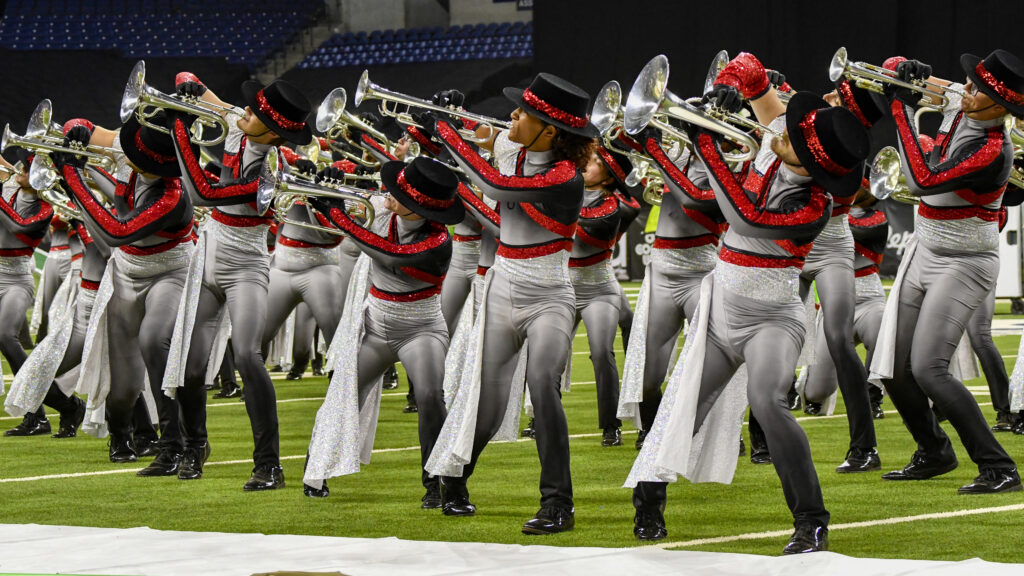To help celebrate the beginning of the yearlong celebration of the nation’s Bicentennial, the 1975 Drum Corps International World Championships went to the city where the Declaration of Independence was signed.
The 1975 Finals competition was the first to be preserved by professional videographers when for the first time PBS live-broadcasted the show from Philadelphia.
The Madison Scouts won their first DCI title despite Santa Clara Vanguard winning all the General Effect captions of the day. It was a feat that wasn’t repeated until decades later by the 2014 Blue Devils. (In 1975, there were three General Effect judges, one each for Horns, Drums, and Marching and Maneuvering. In 2014, there were four GE judges spread across GE1 and GE2.)
In 1975, the 10th-place Phantom Regiment introduced the corps’ new uniforms, consisting of white jackets with a chevron logo prominently displayed on the right sleeve and white pith helmets that have been a mainstay with the corps ever since.
Regiment opened its production with Joseph Wilcox Jenkins’ “American Overture for Band,” a 1953 work by the composer who was the arranger for the United States Army Chorus and the U.S. Army Field Band. The overture, his first work for concert band, quickly soared to the top of the repertoire for the rapidly evolving world of wind bands. Not much earlier, bands had largely been relegated to performing transcriptions of orchestral works.
The overture famously opened with the jump of an octave in the French horns, replicated by Regiment in the mallet keyboards. It may have been difficult to have the corps’ French horn players attempt that figure right from the start of the production, but they did play the octave jump numerous times throughout the piece, which ended with the timpani replicating the figure as the show transitioned into a drum solo that led into “Hungarian Dance No. 5.”
Johannes Brahms wrote the work in 1869 as part of his collection of 21 energetic dances for piano. It was published in the first book of the dances, 11 years before books three and four completed the set. Brahms was inspired to write the dances after hearing gypsy music on the streets of Hamburg, Germany, performed by refugees of the Hungarian Revolution. While Antonín Dvořák is known for orchestrating many of the dances for orchestra, Prussian army music director Albert Parlow was chosen by Brahms to provide the orchestral setting for the fifth dance. Regiment’s brass players only played the melody through one time, making for a relatively short production of just over 30 seconds.

Famed Italian opera composer Gioacchino Rossini wrote the comic opera “Barber of Seville” in 1815, though the overture everyone has come to know was recycled from two previous operas. The work failed miserably when it was premiered, jeered by an audience largely comprised of fans of Rossini’s now-forgotten operatic rival. But reactions at subsequent performances, held within a week of the first one, turned the opera into a smashing success. Regiment utilized the piece alternating bombastic brass hits with delicate elements from the opera’s overture.
In 1928, superstar Broadway composer George Gershwin wrote “American in Paris,” inspired by his visit to the French capital. According to Gershwin, “My purpose here is to portray the impression of an American visitor in Paris as he strolls about the city and listens to various street noises and absorbs the French atmosphere.”
Gershwin personally brought to America the Parisian taxi horns that are so integral to any orchestral performance of the work, replicated by the dissonant bursts of the corps’ sopranos. The piece started with Regiment’s drum major portraying a Parisian traffic gendarme, dodging the city’s traffic, represented in the scatter drill formations. The corps pretty much covered all the themes of the 18-minute work in a tidy package of three-and-a half minutes, concluding with a company front that gave a hint of the horn line’s potential for the massive sound it would be producing in the coming years.
The show ended with Richard Wagner’s “Pilgrim’s Chorus” from the composer’s 1845 opera, “Tannhäuser,” based on two German legends about love. In the opera, the song represents the journey of pilgrims to Rome to seek mercy and forgiveness for their sins. With its soaring choral accompaniment, the work is generally regarded as one of the most beautiful ever written for an opera. The corps utilized this piece to present the American flag, bringing the color guard down front in a circle of sequentially billowing flags and spinning rifles encircling the flag,
In 1976, Phantom Regiment would jump to 4th place and would capture 2nd place each of the following three years, becoming a force no other corps could ignore.
For this week only, you can save on the Legacy Collection DVD that contains this complete Phantom Regiment performance.
Buy the 1975 Legacy Collection DVD.
(Available 20% off for a limited time only.)
1975 Overview
Discount DVD offer ends Monday, May 30, 2016.

Michael Boo was a member of the Cavaliers from 1975-1977. He has written about the drum corps activity for more than 35 years and serves as a staff writer for various Drum Corps International projects. Boo has written for numerous other publications and has published an honors-winning book on the history of figure skating.
As an accomplished composer, Boo holds a bachelor’s degree in music education and a master’s degree in music theory and composition. He resides in Chesterton, Indiana.





